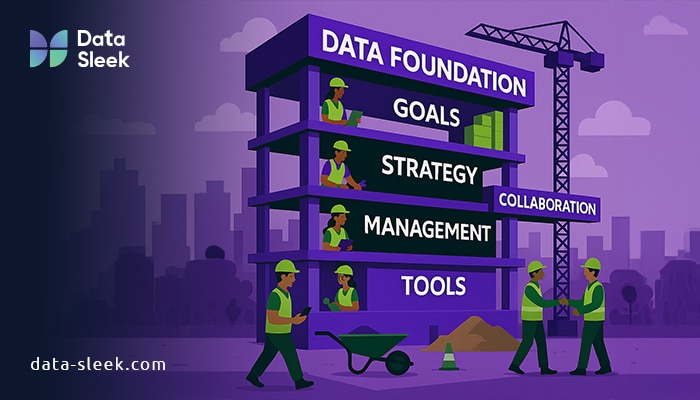Data is the new gold or the new oil in the modern age, as it tells businesses everything they need to know about their existing or potential clients and customers. And just like gold or oil, data only becomes valuable when it’s refined and used effectively, which requires both strategy and management.
However, before you can manage and use any tool at your disposal, you need to understand it, and the same applies to data. Your business might be sitting on an actual treasure trove of data, but without a proper data strategy and adequate data management, that data isn’t effectively utilized.
In this guide, we’ll go over two very important concepts of data governance—data strategy and data management, and why one comes before the other. We’ll also examine the debate around data strategy vs data management, how they intersect, and when one should be prioritized over the other.
What is Data Strategy?
A data strategy defines how your organization leverages its data as a business asset. This long-term outline of what types of data an organization collects, as well as the technology, processes, people, and rules required to manage an organization’s data assets.
It’s easy for companies to get caught in the trap of accumulating vast data lakes without knowing what to do with that amount of data. That’s where strategy comes in; it outlines the organization’s long-term vision for collecting, processing, storing, sharing, and using the data within an organization.

This makes working with data much easier, as it makes it well-organized, structured, and accessible to all members of your organization or business. Developing a sound data strategy is important, as it helps your business remain competitive and innovative in a fast-paced market.
A well-defined data strategy is more than just a technical playbook; instead, it ensures that the data you collect supports your company’s business goals, from improving customer acquisition to optimizing operational efficiencies.
It’s also important to note that a data strategy isn’t just about IT. It also intersects with organizational culture, various team roles, business workflows, and even long-term planning. In the context of data management, data strategy provides the “why” behind every data project or implementation.
Elements of Data Strategy
Though it may sound like data strategy is something that strictly deals with data and technology, the concept also encompasses cultural dimensions as well and includes aspects such as data literacy, roles, and responsibilities. You’ll find the core elements of data strategy below:
- Business-Aligned Goals—A data strategy should articulate a clear vision that aligns with the broader goals of your business. These goals may include increasing operational efficiencies, unlocking new revenue streams, enhancing customer experience, or all of the above. Whatever the case may be, the data strategy must articulate how the data will be used to achieve specific and measurable goals.
- Technology and Architecture—As previously mentioned, a good data strategy has to identify the right tools and technologies to support your architecture, analytics, and data governance. Regardless of the type of data and its use, you should strive for a scalable, interoperable, and cost-effective tech stack. Similar applies to the architecture; a good strategy has to outline the relationship between different systems and how data flows throughout the organization.
- Roles, Responsibilities, and Governance—A clear data strategy outlines responsibilities across an entire organization, thus defining different roles for analysts, engineers, data stewards, and data governance committees. It should also establish data ownership and access policies to purposefully eliminate ambiguity and risk.
- Talent and Skill Planning—Besides outlining the technology, rules, responsibilities, and governance, it’s also important to educate your employees on how to understand, interpret, and use data effectively so that they can implement and adhere to the data strategy.
- Analytics and KPIs—The real value of data lies in the actionable insights it provides, and a good data strategy has to define how data will be analyzed and its insights used to support decision-making, basic reporting, and advanced machine learning models. Analytics will also help track your Key Performance Indicators (KPIs), which help measure your progress and grant you actionable insight into the effectiveness of your data strategy.
What is Data Management?
As previously stated, data management is basically the execution of your data strategy. In other words, your data strategy is the “what” and “why,” but your management is the “how.” The concept basically refers to the operational processes and technologies used to collect, store, and maintain data on a daily basis.
Additionally, effective data management also ensures that high-quality, accessible, and governed data is available for stakeholders to derive insights from. Even the best-laid data strategies will inevitably fail without strong data management practices. This makes data strategy vs data management a matter of alignment, not competition.
Components of Data Management
Data management relies on its core components to ensure efficient data handling and availability. These include:
- Data Governance—Data governance refers to the process of enforcing associated with data access, privacy, compliance, and use, as defined by the data strategy. Data governance also ensures that your organization handles data ethically and legally, in accordance with both internal standards and external regulations. For businesses that handle sensitive information, this helps avoid legal issues and fines, as well as reputational damages.
- Data Quality—Data quality refers to management processes that continuously assess and improve data accuracy and consistency across all relevant levels of your organization. Poor data quality often leads to faulty and flawed insights, leading to poor decision-making. Thus, the purpose of data quality management is to ensure that the data is clean, re-duplicated, and validated before it can be used reliably.
- Data Architecture and Infrastructure—Data architecture refers to how data is structured within your organization. Data warehouses are optimized for structured data and support analytics and reporting functions, while data lakes work better for unstructured or partially structured data.
- Data Lifecycle Management—Managing data throughout its lifecycle isn’t just important for operational efficiency; it’s also important for regulatory compliance. Because lifecycle stages also include the eventual disposal of data, this type of management ensures that the regulations surrounding data collection, storage, and disposal are adhered to.
- Tooling and Automation—Tools for ETL, data lineage, cataloging, and quality monitoring are also critical components of data management, as they reduce human error and process data at faster rates. This eliminates the associated delays and reduces the time analysts need to derive actionable, data-driven insights that promote growth.
Strategy vs Management: Practical Distinctions
As they’re pertaining to data and how businesses use said data, there’s plenty of confusion between data strategy and data management. However, while the two are related, they’re not the same. Think of your data strategy as the architectural blueprint and your data management as your construction team.
You can’t build a structurally sound data operation without both, regardless of the fact that they serve fundamentally different purposes. The most notable differences between data strategy vs data management can be found in the table below:
| Aspect | Data Strategy | Data Management |
| Goals | Define long-term vision and priorities for the use of data | Define how to care for the data (Ensure data quality, consistency, and availability) |
| Scope | Broad—encompasses tech, architecture, culture, and talent | Narrower—focuses on operational processes, integration, and data maintenance |
| Stakeholders | Executives, business leaders, data strategists, senior leadership | Data engineers, data stewards, IT teams, analysts |
| KPIs | Data-driven innovation, ROI on data assets | Data accuracy, uptime, compliance, and process efficiency. |
Purpose and Focus
Data strategy’s primary focus is fundamentally strategic, as it aims to align data efforts with business goals. On the other hand, data management is operational, ensuring that day-to-day data operations run smoothly and efficiently.
Planning and Execution
Since it is fundamentally strategic, data strategy involves long-term and high-level planning, which includes establishing policies and roadmaps, governance frameworks, and even investment priorities. As such, its goals often span 3-5 years. Data management involves directly implementing the data strategy and the mechanics of data storage, access, and transformation prescribed by said strategy on a daily basis.
Decision-Makers
Data strategy is often led by Chief Data Officers (CDOs), Chief Information Officers (CIOs), and executive stakeholders. Data management is handled by operations teams, data engineers, and system architects.
When to Prioritize One Over the Other
We previously explained that data strategy and data management go hand-in-hand and that one can’t effectively operate without the other. In most cases, data strategy should precede data management, as it also outlines how data is managed. But that’s not always the case.
Startups and mid-sized businesses building from scratch should prioritize developing a solid data strategy that aligns with their business goals. This will help such companies avoid technical debt, the accumulation of disparate tools, and the formation of data silos.
For example, let’s say a SaaS company wants to reduce churn. A strategy-first mindset helps the company identify what customer behavior data matters most, build the right KPIs, and structure its data stack accordingly. Data management then ensures that such data is captured and analyzed consistently.
However, the same doesn’t apply to data-heavy enterprises with weak data strategies and legacy systems. No strategy, regardless of how well-defined, can succeed if the current infrastructure is fragmented or non-compliant.
Such enterprises are more likely to extract the most value and benefits from their data by improving data management practices. Only after governance rules are established and applied, and the data has been cleaned up should those enterprises focus on creating a long-term data strategy.
Real-World Example: Data Strategy Misaligned with Management
Let’s consider a healthcare provider that seeks to use integrated analytics to improve patient outcomes. Their strategy might call for unified patient profiles across different departments, but without adequate data management to ensure high-quality data, the strategy can’t deliver. The results are missed insights, duplicated records, and clinical inefficiencies.

On the other hand, management without strategy is simply a different failure, the one that implies doing the work without knowing why that work is being done. For example, a retail brand might have a pristine cloud warehouse and ETL pipelines but no clear idea of how to use their data to improve profit margins or customer retention. The result is operational excellence at a standstill.
Aligning Data Management and Data Strategy
Aligning data management with data strategy means building a unified data foundation. It starts with intentional design and collaborative planning across technical and business teams, which need to:
- Define Business Goals First—Ensure that your data initiative serves a well-defined business outcome, like improved customer experience or increased profitability. You should also identify what kind of data your business needs to support its previously defined business goals.
- Audit Current Infrastructure—Before making any adjustments to your data strategy or data management practices, it’s a good idea to audit your current architecture, storage, governance, and tools.
- Invest in Data Literacy—As previously mentioned, you should invest in the data literacy of your employees so that they can implement your strategy and manage your data more effectively. Never let tooling outpace talent.
- Choose Interoperable Tools—Choose platforms and technologies that support both your current needs and future growth. Integrate them into cross-functional workflows where everyone collaborates towards closing a strategy-execution gap.
- Monitor KPIs and Iterate—Both strategy and management require continuous improvement. Monitoring your KPIs, reviewing your performance, and auditing your data periodically ensures that your strategy and your management are performing at their highest levels and evolving along with your business.
Common Pitfalls to Avoid
Without an adequate data strategy in place, things can easily go sideways. One of the most common missteps is treating your data strategy like a one-time project when it should be treated like a continuously evolving framework.
Another common mistake is overinvesting in tools and underinvesting in people. Sure, AI solutions are great, but without the right people to guide and oversee different processes, even the best models fall short. A platform is only as good as the team using it.
Ignoring data quality is another common pitfall; poor data hygiene can and will sabotage both analytics and AI efforts. It really pays to have clean, consistent data across the board.
Ready to Align Your Data Strategy and Management?
In summary, data strategy and data management are two sides of the same coin. While strategy points the way, management delivers. One simply isn’t complete with the other, and prioritizing one over the other is a matter of circumstance, not preference.
By understanding where strategy and management diverge and how they connect, IT leads and analysts can architect data systems that are both technically sound and perfectly aligned with your company’s business goals.

If you’re unsure where your organization stands or how to move forward, reach out for a free consultation with our data experts—we’ll help you evaluate, align, and evolve your data foundation.
FAQ
Here are some of the most frequently asked questions about data strategy vs. data management:
How does a data strategy shape long-term business growth?
A well-defined strategy aligns with organizational goals, thus ensuring that investments in data infrastructure and analytics support smart decision-making, enhanced efficiencies, and sustainable growth.
What role does data management play in ensuring regulatory compliance?
Adequate data management ensures that data is accurate, consistent, and compliant. Without proper governance, lineage tracking, and access control, the organization risks non-compliance, financial liabilities, and reputational damages. Data management mitigates those by enforcing compliance policies.
Why is aligning data management with strategy crucial for innovation?
Because innovation relies on having access to high-quality, reliable data, and having access to such data allows teams to focus on innovation rather than dealing with an inefficient infrastructure.
How can poor data management hinder the execution of data strategy?
Without consistent definitions, governance, and accessibility, there’s ambiguity, which leads to poor management. Poor management results in fragmented systems, inconsistent insights, and decision-making bottlenecks that adversely impact your business.
In what ways do organizational maturity levels influence data strategy implementation?
Organizations at different maturity levels have different capabilities when it comes to data governance, architecture, and analytics. Startups often focus on building their foundational data infrastructure, while large enterprises usually rely on optimized automation and predictive modeling.



